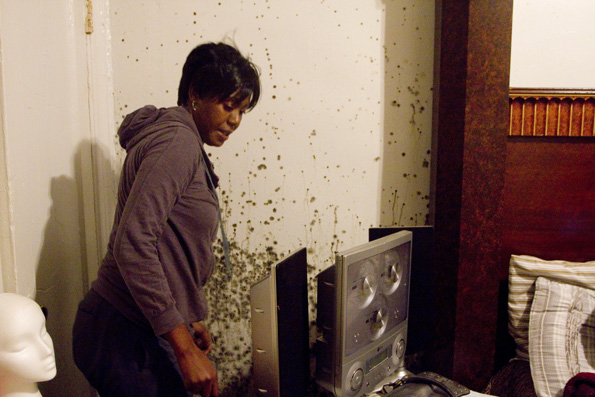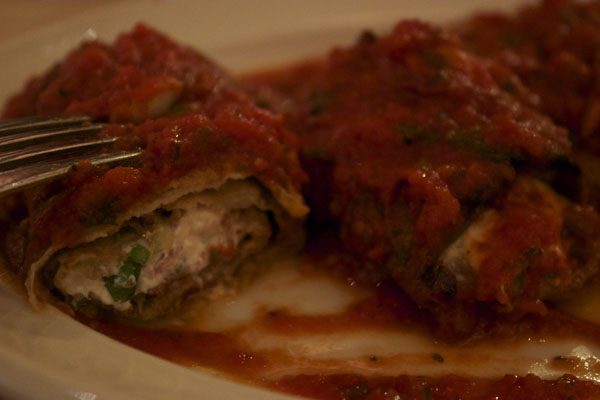
Pastor Rebecca Vega (right) and her sister, Jacqueline Quinones (left), start the first service in the House of Healing's new location. (KIRAN ALVI/The Bronx Ink)
The worshippers who crowded into the living room of the two-bedroom apartment on Marmion Avenue in East Tremont had known more than their share of losses and hardships. Their neighborhood has been through some tough times.
On Aug. 24, a stray bullet on East 174th Street killed Yaritza Pacheco, 24. On Aug. 30, three people, ages 5, 2 and 20, were shot on 180th Street. The next day, Phillip Richards, 35, was gunned down on East 181st Street. On Sept. 17, India Durant, 3, died after being found unconscious in her family’s home on East 180th Street. Kurt Lawrence, 17, was found with a gunshot wound to his chest on Nov. 26 on East 175th Street.
But Pastors Anthony and Rebecca Vega, both 35 and married for 14 years, offer hope and healing in their ministry, which recently moved from their apartment into a location four times the size at 921 East Tremont Ave. On most Sundays, it was a struggle to fit the usual 60 worshippers into their apartment so the new location offers new opportunities for serving the community, they say.
“We’re here to help everyone,” said Rebecca Vega, who has two boys of her own. “There’s especially no place for the youth to go around here. Nothing is free, and we want to give them things to be happy about.”
Those things include preaching to youth members at a Juvenile Detention Center in Westchester once a month and hosting community events geared towards children. On Nov. 12, they hosted a glow-in-the-dark service in Tremont Park, the same location where they handed out book bags and school supplies to anyone who came back in September—all funded with their own money and church donations. The Vegas even let youth members lead services on Fridays.
“What else do they have?” Rebecca Vega said. “It’s hard growing up in an environment where not only do you not have a lot, but then things, people get taken from you too.”
The Vegas know what it is like. In 2005, their seven-year-old daughter, Abigail, died of acute metabolic acidosis, a condition in which the body either produces too much acid or the kidneys do not remove enough from the body. But after a part of their family “broke away,” Anthony Vega said, they were able to help join others.
Rebecca Vega and her sister, Jacqueline Quinones, start the service with Spanish-language religious songs. Neither is shy with volume. And as some congregationalists play tambourines and drums, others loudly sing along, falling into a trance with the rhythmic melodies. The hand-holding, emotion-filled room gears up the church for the equally lively sermon given by Anthony Vega and Quinones’ husband, Melvin.
“It’s like a family here and they really care about us, it’s like they’re our friends,” said Joanna Garay, 15, who joined the church in 2010 after stumbling upon a picnic the ministry had outside the apartment building. “There are so many kids doing the wrong things around this area but kids like it here so they come and can stay out of trouble.”
“The church brought my family together,” said Garay, who did not come from a churchgoing family but has not missed a service since she first attended. “And now it feels like the church and everyone in it are my family.”
Garay’s mother went with her daughter one day and then forced her other daughter, Valerie Lovo, to come. Today, Lovo is also an active member and led a service in the orange-painted living room on Oct. 14.
Joanna Castro, 30, of Staten Island said that the living room in the Bronx changed her life.
She found out about the House of Healing through a friend in 2006 and used to make the hour-long drive on Sundays. The pastors helped her find the confidence to get out of an abusive 13-year relationship in a year ago. On Oct. 2, after packing up the painful memories of Staten Island, she moved into an apartment Rebecca Vega helped her find, just four blocks away from the ministry.
“I held on too long to the pain and the hardships I endured,” Castro said. “The pastors just told me that God has bigger plans for you and they helped me get out of it.”
The neighborhood is home to many residents who have a lost many things, including hope, Anthony Vega said. “Then they end up making the wrong choices, and through God and positivity we want to help them find the strength to get through it.”
Instead of walking through their apartment door every weekend, the ministry’s more than 60 people—almost half of whom are under 12 years old—will now be walking into a building and onto the second floor of a new House of Healing.
“We’ve moved into our new location, but we don’t want the feeling to change,” Anthony Vega said seated in his now-empty living room. “We’re going to put a sign outside that reads ‘Welcome Home.’”
“We’re not healed,” he said. “So we want to help others heal and maybe we can all heal together. Not all is lost.”























